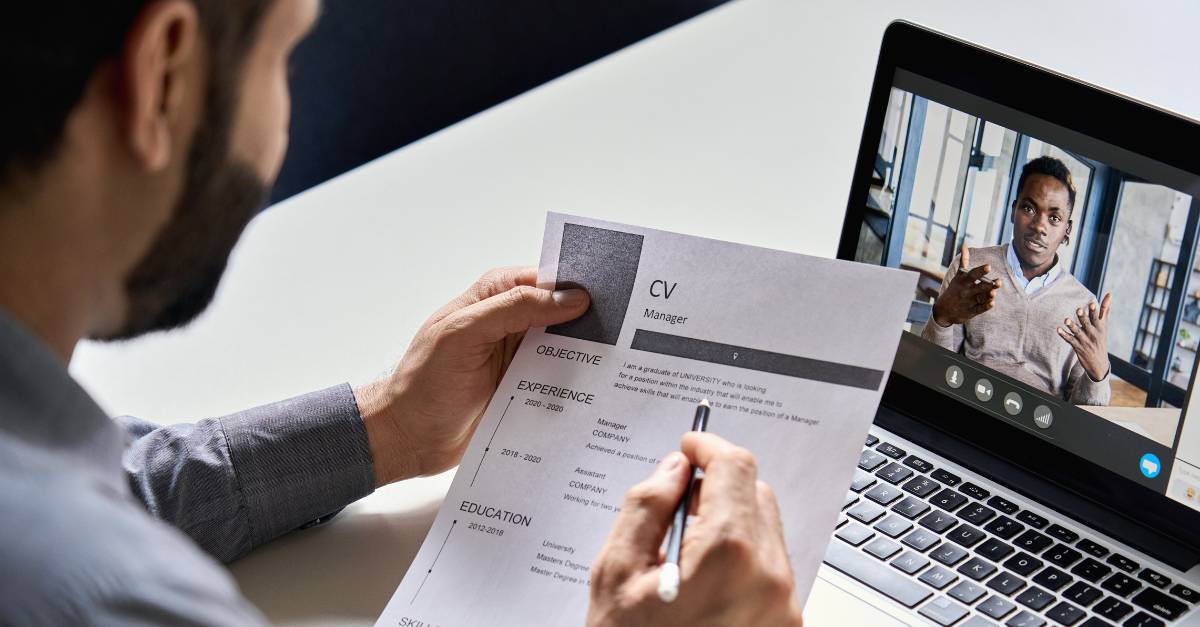
The ultimate guide to prepare for a video job interview

Businesses are rapidly adapting to better digital practises, including shifting the recruitment process and adopting the use of video technology for jobs interviews.
At Six Degrees Executive, recently underwent rapid digital transformation to transition our services online. We understand job interviews can already be stressful and for many people, adding technology to the mix creates more tension, so we’ve put together our top tips on how to prepare and conduct a job interview online.
Just like a face-to-face job interview, preparing in advance for your virtual job interview will help you be at your best on the day. While video interviewing is a different experience to face-to-face interviews, there are substantial similarities in the way you prepare, with much of your previous job interview experience able to be translated to work online.
7 steps to a successful online job interview
The key differences to recognise are in the way you set up and prepare to use digital technology, so you will need to plan and allocate preparation time in a new way. These video tips and tricks will help you prepare and recalibrate for your virtual interview experience.
1. Know the platform
Technology adds the potential for complications and often means things can go awry. Ample practice, preparation and testing is required to familiarise yourself with the software platform being used for your job interview. Video platforms such as GoToMeeting, Microsoft Teams, Skype, and Zoom each work in slightly different ways, so it’s good to be comfortable with the technology in advance. Download and install the platform you will use the day prior to avoid any last-minute surprises and allow ample time to test directly prior to your interview so you can remain relaxed and focused on the day.
2. Find an optimal interview space
One of the key differences to consider is the environment you set up and use for your interview. You will need to scout out and set up a suitable location ahead of time to ensure optimal lighting, positioning, sound and setting, as well as ironing out any crinkles with the device you are using.
Interviewing from home provides an insight into your life for both interviewer and interviewee, so it’s important to present the right impression. It’s important to test your device’s video camera through the software being used to check these key elements:
- Setting. Find a quiet place away from potential disruptions and distractions where you can concentrate and focus. If you have a spare room that can be closed off with a sign on the door, that’s optimal. If you are liberating another space in your house, make sure the space is free from clutter and busyness, and let your family or flatmates know ahead of time that you need some peace and quiet. If it’s difficult to interview from home, consider using an appropriately set up coworking space.
Check how the background appears through your device camera to find a professional, simple, static backdrop. Cluttered, complex or moving backgrounds will create motion blur and use extra bandwidth during the interview. Video platforms like Microsoft Teams provide the option to blur or change the background as a last resort. - Position. The setup of your device camera is important – think about which device you will use for your interview and test your setup the day prior. Find a comfortable, seated position to avoid any unnecessary movement in the frame and position your camera at eye level. You may need to prop up a laptop or screen to position the camera at the right level, so desktop or laptop computers are preferable as they provide more stability than a mobile device. We’ve already had some interesting instances of cameras and phones fall down during interviews and revealing more than intended!
Gauge how far away to sit so your face is clearly visible without being too close or far away from the camera. A rule of thumb for the ideal distance is to show your head and upper torso and occupy approximately one-third of the visible space in the shot. - Lighting. Natural light works best if available, but if you are using artificial lighting you will need to check the position of lights to ensure they are not creating glare or shadows. For natural light, you may need to consider the time of day your interview will be conducted to test the direction of the sunlight at the same time of the day prior. Make sure there are no light sources or windows directly behind, which can result in your face being in shadow. Just as it’s best not to take a portrait photo facing into the sun, your device camera should not face into a light source.
- Sound. In addition to your space being private and quiet, you will need to ensure the sound quality so you can be heard clearly. Avoid coffee shops or public spaces where your microphone will pick up background noise. Ensure your space is free from other devices which may interfere with the video connection or sound quality.
If you need to use headphones to hear properly, it’s a good idea to set them up beforehand. Smaller headphones are preferable, so they don’t look bulky and take attention away from what you are saying. Adjust your computer settings in the application you are using to connect the sound through your chosen headphones instead of using your computer speakers.
3. Prepare what you wear
When deciding what to wear, consider your outfit as you would for a face-to-face interview but note a few tips to help you present well on video:
- Dress from the ground up, including appropriate pants and shoes. We’ve already seen some interesting instances where people have been caught short, so we highly recommend the full attire you would normally wear to an interview.
- You may need to adapt your outfit to appear well online - avoid wearing patterns and hot colours such as pink and red which can ‘flare’, or too much total black or white in your outfit. Mid tones are easier for the camera to pick up and will make you appear better. Interestingly, busy clothing patterns can use more bandwidth and may result in a poor connection!
- Avoid shiny surfaces that can sparkle or reflect such as glasses, jewellery or sequins. If you wear glasses, ensure you can still see your eyes and check you don’t create unwanted reflections.
4. Do a test run
Transform the time you would take for travel and planning into time for testing, so you are ready to roll and be more relaxed about the interview.
With so many people working from home, it’s a good idea to test your internet speed to make sure you have good bandwidth (at least 1 megabit per second) for video.
Rebooting your computer, updating your web browser to the latest version, making sure you have enough data, and doing a practice call using the video software is also recommended. Most software lets you test your video and sound, otherwise get a friend to install the software to do a test call in advance.
5. Normal interview preparation
After all the tech-prep, it’s important to allow enough time to prepare for the interview with your recruiter or potential employer to work out if you are suitable for the role. You should still do your research about the company and think about examples that demonstrate the job competencies required.
Have high-impact questions prepared, ensure you understand the company culture and role requirements, ask about the ‘where to from here?’ and anticipated timeframe for the recruitment process. You should still follow up post-interview to confirm your interest (or likewise if you are not interested) and clarify any outstanding information.
6. Special interview tips for video
- Interviewers should confirm the structure of the interview, whether it will be recorded, and if they will take notes during the interview to set expectations.
- Ensure your device is charged or plugged into power and that you exchange phone numbers to communicate in case your technology fails.
- During the interview, keep other devices out of reach that could interfere with your connection or concentration.
- Take extra devices off your Wi-Fi network to improve the quality of your connection.
- Close down any unnecessary programs or browser tabs, turn off notifications that may appear on the screen, and switch your phone to silent or voicemail.
- Grab yourself a glass of water on the day (placed outside of spilling-distance).
- Practice answering questions and speaking on camera to appear more natural during your interview. Record yourself to view your body language and listen to the way you speak.
- You can cheat! Write notes as prompts to remember examples to use and questions to ask - use sticky notes on the side of your screen rather than flicking to online notes.
- If you talk with your hands, try to limit your movement where possible, as it creates motion blur and can be distracting to the other person.
- Remember to focus your attention on the camera lens rather than the other person’s image on your screen to appear to look each other in the eye, and limit how often you look away or check yourself on the screen to avoid your eyes darting back and forth.
- Even though you are interviewing online, you can still start to build a personal connection and relationship. Consider your welcome greeting, introduction and small talk to start off on the right foot and put each other at ease.
7. Prepare for the unexpected
Virtual interviewing is new for most people so being patient and understanding will help us all get through this recruitment transformation together. People are generally quite forgiving, but it pays to make sure you’ve done everything you can to set yourself up for success.
If your interview gets interrupted by a child, flatmate or pet, it’s the way you handle the situation that matters. A calm and polite response to the circumstances will show you can be cool under pressure.
As with a face-to-face job interview, being thoroughly prepared and remaining authentic will increase your chances of success.
Need more interview advice? Connect with a recruiter in your area.

Related


How learning and development drives talent retention and growth
In the ongoing quest to attract and retain top talent, organisations are discovering that offering...

6 winning leadership traits you won’t see on a resume
Leaders once ascended to leadership positions in the C-Suite based on their expertise and as a...

 Accessibility
Accessibility